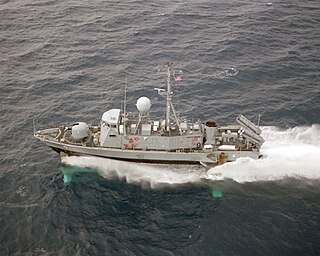The United States Navy, United States Coast Guard, and United States National Oceanic and Atmospheric Administration (NOAA) use a hull classification symbol to identify their ships by type and by individual ship within a type. The system is analogous to the pennant number system that the Royal Navy and other European and Commonwealth navies use.

The Pegasus-class hydrofoils were a series of fast attack patrol boats employed by the United States Navy. They were in service from 1977 until 1993. These hydrofoils carried the designation "PHM" for "Patrol Hydrofoil, Missile." The Pegasus-class vessels were originally intended for NATO operations in the North Sea and Baltic Sea. Subsequently, participation by other NATO navies, including Germany and Italy, ceased and the U.S. Navy proceeded to procure six PHMs, which were highly successful in conducting coastal operations, such as narcotics interdiction and coastal patrol, in the Caribbean basin.
USS Pegasus is the name of two ships of the United States Navy:
Five ships of the United States Navy have borne the name USS Hercules, after Hercules, the Roman name version of Heracles. Hercules also is the name of a constellation.
USS Taurus is a name used more than once by the U.S. Navy, after the constellation Taurus:
Two ships in the United States Navy have been named Aquila after the constellation Aquila.

USS Pegasus (PHM-1) was the lead ship of her class of hydrofoils operated by the United States Navy. Pegasus-class vessels were designed for high speed and mobility, and carried a powerful armament for their size.

USS Gemini (PHM-6) was the final ship of her class of hydrofoils operated by the U.S. Navy. She was named for the constellation.

USS Aries (PHM-5) is the fifth ship of her class of hydrofoils operated by the United States Navy. Pegasus class vessels were designed for high speed and mobility. Despite being small in size, they carried a large 76 mm gun. Aries was named for the constellation.

The second USS Aquila (PHM-4) was the fourth ship of her class of hydrofoils operated by the United States Navy. Pegasus-class vessels were designed for high speed and mobility, and carried a powerful armament.

USS Hercules (PHM-2) was a United States Navy hydrofoil patrol vessel operated from 1982 to 1993. Pegasus class vessels were designed for high speed and mobility and carried a powerful armament for their size. The Hercules was named for the constellation.

USS High Point (PCH-1) was a High Point-class patrol craft of the United States Navy in commission from 1963 to 1975. She subsequently was in commission in the United States Coast Guard briefly in 1975.
USS Delphinus has been the name of two ships of the United States Navy, named after Delphinus, a northern constellation.

HMCS Bras d'Or was a hydrofoil that served in the Canadian Forces from 1968 to 1971. During sea trials in 1969, the vessel exceeded 63 knots, making her the fastest unarmed warship in the world at the time.

The USS Tucumcari (PGH-2) was a Boeing-built hydrofoil. Named after Tucumcari, New Mexico, it was the basis for the technology used in the subsequent Pegasus-class patrol boats and the Jetfoil ferries. Its unique feature was a waterjet propulsion and a computer-controlled fully submerged foil configuration of one foil at the bow and foils on the port and starboard sides. The Tucumcari was one of two prototype boats contracted by the Navy under project SCB 252 for the purpose of evaluating the latest hydrofoil technology. The second boat was the rival Grumman-built USS Flagstaff (PGH-1).

Boeing has designed and built several hydrofoil craft for both military and civilian use.

The Sparviero class, also known as the Nibbio class, are small hydrofoil missile boats capable of traveling at speeds of 46 knots. They were designed for and formerly used by the Italian Navy. The Japanese 1-go-class missile boat is an updated version formerly used by the Japan Maritime Self-Defense Force (JMSDF).

The Matka class is the NATO reporting name for a group of hydrofoil missile boats built for the Soviet Navy. The Soviet designation was Project 206MR Vikhr. Following the 1997 Black Sea Fleet partition treaty all Black Sea Fleet Matka class boats were passed to the Ukrainian Navy.

The Sarancha class is the NATO reporting name for a hydrofoil missile boat built for the Soviet Navy. The Soviet designation was Project 1240 Uragan.

PHM Pegasus is a ship simulation and action game released for the Commodore 64, Apple II, DOS, Amstrad CPC, and ZX Spectrum. The title refers to USS Pegasus (PHM-1), one of the Pegasus-class hydrofoils which were used by the U.S. Navy in the 1970s.














